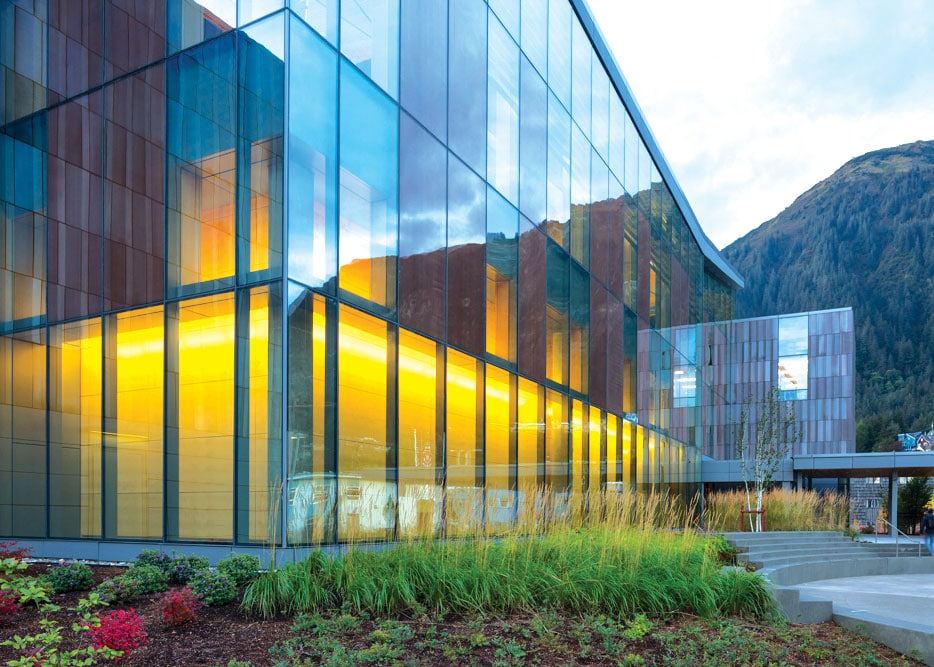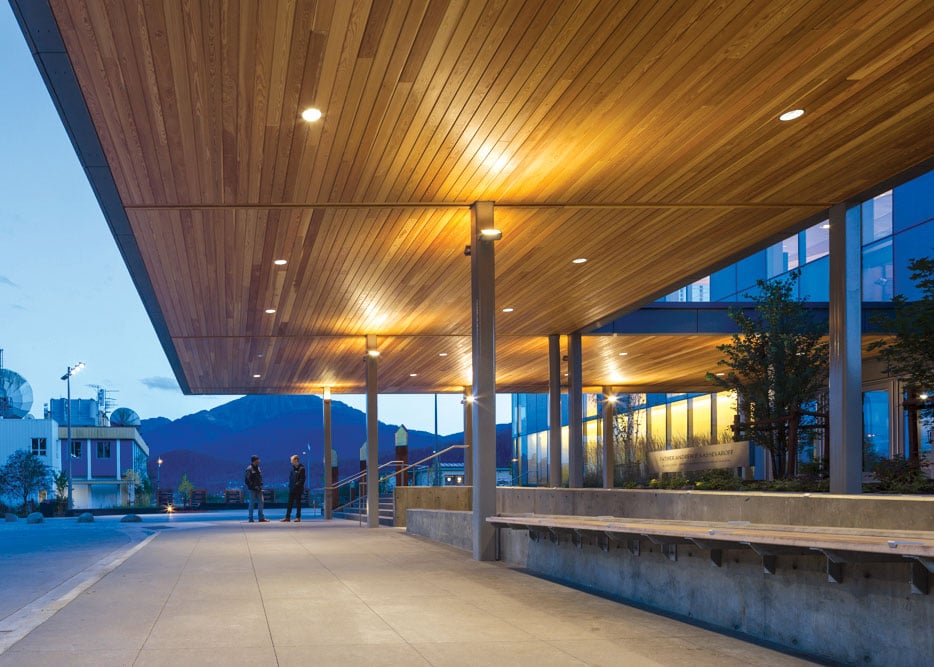
The curtain wall system and exterior incorporated materials important to Alaskan culture—copper, zinc, and terra-cotta, which helped the structure blend into the surrounding rugged landscape. [Photo: Courtesy of Andrew P. Kashevaroff Library, Archives and Museum]
- SIZE: 118,000 square feet / 34,000-square-foot parking garage
- COST: $140 million / $101.7 million in construction costs
From the very first sketches, the new Andrew P. Kashevaroff Library, Archives and Museum in Juneau, Alaska was designed to last generations. “One of the original, repeated mantras for this project was to design it to be a 100-year structure,” says PCL Construction project manager Tyler B. Kautz.
Meant to house the State of Alaska’s historical archives and its most valuable, priceless artifacts, the museum (owned by the Alaska Department of Transportation and Public Facilities) would be the largest building project the city of Juneau had undertaken in 40-plus years. PCL Construction was brought on to lead the endeavor together with a team of architects, civil engineers, landscape designers, and mechanical, electrical, and plumbing experts.

[Photo: Courtesy of Andrew P. Kashevaroff Library, Archives and Museum]
That included designing building systems that would provide precise temperature and humidity control to safely preserve the items inside as well as an environment that would minimize handling of the artifacts—one that would last well into the next century.
For PCL, incorporating green technologies was critical to meeting these needs. That included a cooling system powered by the tides—the primary source of cooling for the 118,000-square-foot building. “The building has three wells that pull brackish water from underneath the building, send it through a heat exchanger, and out into a culvert that feeds into the ocean. Constantly replenished by the tides, we have an endless supply of free cooling.”

[Photo: Courtesy of Andrew P. Kashevaroff Library, Archives and Museum]
Air quality concerns were met with dedicated outdoor air units (DOAs) that utilize waste heat, pull heat and moisture from the exhaust air, and even treat it. To combat Alaska’s brutal weather, the building’s roof, exterior curtain wall system, below-grade concrete walls, and foundation were designed to withstand the worst wind, rain, and snow Juneau could throw at them.
We designed it to be a 100-Year structure.
But aesthetics and using local, symbolic materials were just as critical in making sure the space became part of the community. The curtain wall system and exterior incorporated materials important to Alaskan culture—copper, zinc, and terra-cotta, which helped the structure blend into the surrounding rugged landscape.

[Photo: Courtesy of Andrew P. Kashevaroff Library, Archives and Museum]
Designing this massive undertaking wasn’t the biggest challenge, though. Finding a place to house the more than 32,000 historic artifacts safely while the old museum was demolished was a feat of engineering unto itself. For security reasons, the artifacts couldn’t be stored offsite. “We had to develop a plan to demolish the old museum on the project site and [construct] the new museum while keeping over 32,000 historic artifacts onsite during the work,” Kautz says.
And did we mention much of the work occurred during Alaska’s famously harsh winters? The solution was to construct secure storage vaults to hold the artifacts while the new museum was constructed and the old demolished. The items were moved in phases through a temporary tunnel system.

[Photo: Courtesy of Andrew P. Kashevaroff Library, Archives and Museum]
After 15 years of careful planning, design, and deliberation, the Andrew P. Kashevaroff Library, Archives and Museum opened on June 6, 2016, just one year before the 150th anniversary of the Alaska Purchase.
Today, museum guests are transported into Alaska’s diverse history from the moment they walk into the spacious, high-ceilinged lobby and through the exhibit hall doors, beyond which a complete history of Alaska’s origins—from the native peoples of this awe-inspiring landscape to its role in World War II—awaits exploration.
